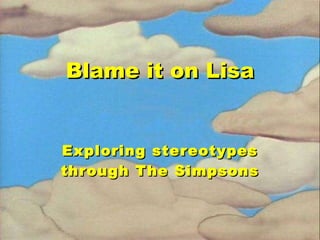Blame it on lisa
- 1. Blame it on Lisa Exploring stereotypes through The Simpsons
- 2. The episode The family travels to Rio de Janeiro in the search of Ronaldo, a slum orphan Lisa has sponsored. The Simpsons’ adventures in the South American city are interspersed with plenty of clichés and stereotypes about the Brazilian society. MIVCI 2009-10
- 3. Brazilian clichés Poverty Rio is crammed with poorly dressed favela kids running around brightly coloured wrecked houses in order to avoid being bitten by herds of wild monkeys. MIVCI 2009-10
- 4. Brazilian clichés Lust Sex seems to be Brazilians’ main concern. The most popular kids show on TV – Teleboobies - is conducted by a stripper. MIVCI 2009-10
- 5. Brazilian clichés The Brazilian male is depicted as a basically frisky creature always ready to flirt with anyone he meets – either male or female. The Copacabana beach dress code is strict: just Speedos. Penetrada is the trendiest dance in Rio MIVCI 2009-10
- 6. Brazilian clichés Crime Although the travel guide warned not to get into unlicensed cabs, Homer is eventually kidnapped by a dodgy taxi driver. A woman distracts Homer and Bart so that her own children can mug them. MIVCI 2009-10
- 7. Brazilian clichés Leisure Brazilians do not need to work: they’d much rather linger around town, lie idly on the beach, dance to conga or get drunk. They feel passionate about soccer: at the hotel reception, all the staff members carry out their tasks as if they were playing football. MIVCI 2009-10
- 8. American clichés Stereotypes are not only focused on Brazil, but also on the Americans’ self-centred spirit. On the plane, Bart is using some recordings to learn Spanish until Marge tells him that the language spoken in Brazil is Portuguese. Homer accidentally drops a manual called How to loot Brazil . MIVCI 2009-10
- 9. Exaggerations and misleading information All the stereotypes included in this episode are commonplace: they add nothing new to the typical preconceived ideas we all have about Brazil, although exaggeration is present for the sake of comedy an satire. MIVCI 2009-10
- 10. Exaggerations and misleading information There are also some innacuracies: Brazil is credited with the invention of the Conga or the Macarena , which is not true. The Amazon and Rio are shown as nearby areas but, in fact, they are thousands of kilometres far from one another. MIVCI 2009-10
- 11. Scope of this episode Brazilians found the show annoying when it was first broadcast and watched by over 11 million Americans in 2002. According to The Guardian, (Tuesday 9 April 2002 ), the Rio Tourist Board was ready to sue Fox for damaging the city’s image. Even Mr. Cardoso, President of the country, declared that “it brought a distorted vision of the Brazilian society”. MIVCI 2009-10
- 12. Scope of this episode The series makers highlighted some stereotypes about Brazil normally assumed by outsiders, though they can hardly reflect the reality of this country. Laziness, lust, poverty and crime are present everywhere else, and cannot summarize the essence of a society. MIVCI 2009-10
- 13. Scope of this episode The Simpsons show has been a steady success for twenty years now and it has reached huge worldwide audiences. However, we shoud bear in mind it is just a tv product whose mere aim is entertainment. In fact, the show can be used with pedagogical purposes to help young viewers to overcome prejudices about foreigners. MIVCI 2009-10
- 14. Lesson planning Learning objectives Activities: Pre-viewing activities While-wieving activities Post-viewing activities Assessment MIVCI 2009-10
- 15. Learning objectives Understand and process the overall verbal and non verbal information provided in a multimodal text ( The Simpsons episode). Spot the stereotypes appearing in the film and critically analyse them, recognizing the devices used in comedy to convey humour and satire. Use the target language to give their opinions, exchange information and draw conclusions. Be able to work in teams, assuming responsibilities Search information on the Internet and use it to draw a chart. MIVCI 2009-10
- 16. Rationale The rationale underlying this lesson planning is based on different methodological principles: Communicative language teaching : most activities focus on communication and authentic materials are used. Tasked-based learning : learners have to apply their communicative competence to undertake the proposed tasks. Cooperative learning : team-work and social interaction are promoted. MIVCI 2009-10
- 17. Activities Pre-viewing activities What do we know about The Simpsons ? Describing the family National stereotypes Finding Spanish stereotypes. Discussion What do we know about Brazil? Group brainstorming and discussion Pre-viewing warming up Helpful tips to successful viewing MIVCI 2009-10
- 18. Activities While-wiewing activities Retrieval chart: Pair work MIVCI 2009-10 Underdevelopment, poverty Lisa is reading a travel guide that warns not to drink tap water in Rio On the plane to Rio Stereotypes What’s going on? Scene
- 19. Activities Post-viewing activities Comprehension questions Brazilian celebrities Quizz and group discussion Drawing a chart: final task Integrating different competences Searching and selecting information Using ICTs Writing a summary MIVCI 2009-10
- 20. Assessment Evaluating the learnig process Did students understand the film? Were the stereotypes spotted? Were they critically approached? Did they engage in successful communication in English when undertaking tasks? Did teams work? Evaluating students’ outcome Students’ work through the whole lesson Learners’ communicative competence Participation and collaboration Marking final task. MIVCI 2009-10
- 21. “ All stereotypes turn out to be true. This is a horrifying thing about life. All those things you fought against as a youth: you begin to realize they're stereotypes because they're true.” David Cronenberg “ The whole idea of a stereotype is to simplify. Instead of going through the problem in all its great diversity – it’s this, or maybe that -, you have just one large statement: it’s this.” Chinua Achebe   MIVCI 2009-10





















